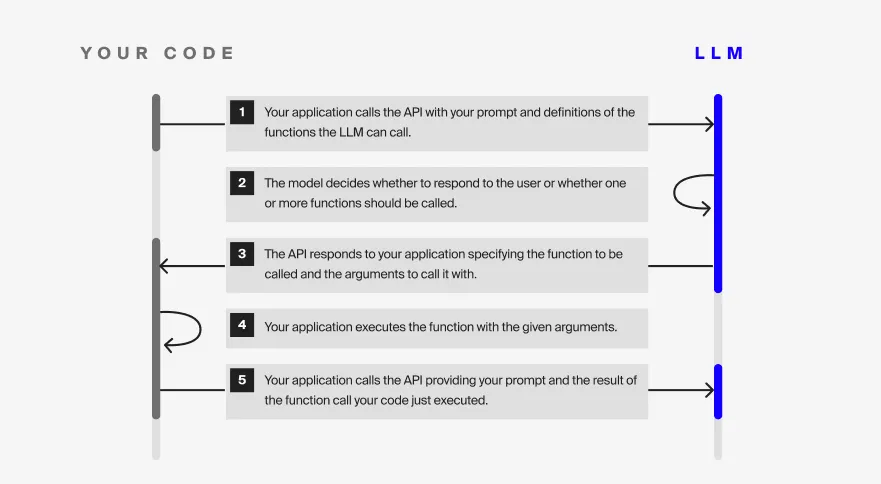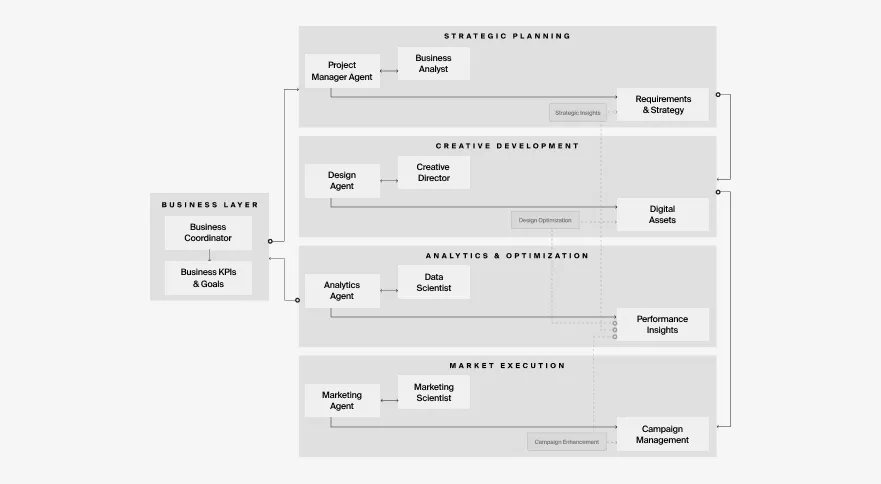insights
Agentic AI: The new unit of work in the modern workplace

insights

What if your workflows could be powered by autonomous systems that think, reason, and act for you? Agentic AI is already making this possible, and it's the next evolution of artificial intelligence. In this blog post, we break down the rise of Agentic AI for two distinct personas: those who build it and those who want to use it. Whether you're a developer or a business leader, this guide will help you understand what an agent is, where it comes from, and why it matters. By the end, you'll have a clear understanding of what agents are and how to unlock measurable impact with these systems, empowering you to innovate and take your business to new heights.
From Big Data to the chatbot revolution, every technological wave has come with hype, but also tangible advancements. Today, all we hear about is how AI will change how we work and the meaningfull impact it can have in our companies and products, when used wisely. Artificial Intelligence is not a new concept and nowadays most people interchanbely use AI and Generative AI, so here we will do the same for simplicity sake.
Starting with some historic context, ‘ChatGPT’ showed to the broader world (and the market) that chatbots when empowered with the right inteligence can be deeply impactful. Soon afterwards, several companies and products started embedding specific ‘ChatGPT’ capabilites like summarization, explanation and information extraction to their products and workflows - the so called OpenAI wrappers were born.
Fast forward to today, those keep on growing and more and more use-cases are being unlocked and discovered as we speak. Currently the hype is more about Agentic AI, in layman terms a ChatGPT that figures out what it needs to do when pointed at a certain interaction and go do it- even if it means interacting with other systems, itself or other ‘ChatGPTs.’ In a more concrete manner - agentic AI is the notion which we can build (semi)-autonomous systems that can reason, act and deliver measurable results. Instead of just answering a question, these systems are designed to execute tasks.
While the buzz around Agentic AI is real, unlocking its full potential requires a deeper understanding of what it is, how it works, and where it can add value.
To help you explore this, we've created a simple web app at https://agents-primer.pages.dev/ - a demo showcasing a multi-agent system inside an instant messaging group. Each agent in the group has its own personality and goals. This is just a minimalistic glimpse of what Agentic AI can do. Use your imagination to envision the possibilities - what if these agents could book a restaurant for you or summarize your emails with ease? The potential is vast, and this demo offers just a taste of what is already possible and what will be widely spread in the near future.
The key factor that empower the chatbots that we relatively used to today to evolve into agents - are systems. A system is a combination of multiple parts. In this case, a Large Language Model is just one of them. For example, a chatbot powered by an LLM is ‘just’ a LLM that does question answering, i.e given a prompt and the historic context it provides an answer. Whilst agents, as we already hinted above, go well beyond this static approach and have or can have way more pieces. Let’s break it down.
At their core, models like GPT or BERT are trained to generate outputs—text, predictions, or classifications—based on input data. They’re powerful but inherently passive.
Key Characteristics:
Models evolved into conversational applications like chatbots, embedding AI within interfaces to provide task-specific solutions. These systems handle FAQs or customer queries but operate within limited parameters. The core difference is that on every call to a model the history and context of the ongoing conversation is passed to the model - the model by itself does not remember, but the system does. This is a very important point. The model by itself does not remember.
Key Characteristics:
The next evolution is agentic AI, powered by paradigms like ReAct (Reason + Act), introduced by Yao et al. (2022). This framework enables Large Language Models (LLMs) to solve complex tasks by combining reasoning with actionable capabilities.
How ReAct Works:
This image extracted from OpenAI Function Calling documentation illustrate this concept quite clearly.

Example in Action:
A ReAct-enabled agent planning a business trip could:
This dynamic interplay is what makes agents autonomous problem-solvers.
When individual agents collaborate, we get multi-agent systems—specialized agents working together to achieve complex goals. We could potentially have a multi-agent architecture where one or more agents are actual humans - in this case we would have multi-agent architectures with humans-in-the-loop. Humans would intervene and be asked to intervene when needed and all other agents would just autonomously try to achieve the task at hand.
Example:
A multi-agent research system might include:
Our interactive demo explores this concept in action. Imagine a WhatsApp-like chat group where multiple agents interact each one with their own personality and agenda, sharing data and making decisions in real time. For example, some can focus on finding and booking the best restaurants that fit your criteria while you’re traveling, others can manage your inbox and calendar to make sure you have time to enjoy lunch.

By now, you should have a clear understanding of what agents and multi-agent architectures are - essentially, LLMs that can orchestrate and execute tasks autonomously. With this foundation, the real complexity shifts to traditional engineering challenges: scalability, maintainability, and integration into real-world workflows.
From here, let’s pivot to the practical side: focusing on use cases, strategic questions for decision-makers, and how to build or buy the right solution for your needs. Along the way, we’ll share insights from our journey and reference key frameworks and tools for those curious to explore further.
A quick side note here. We are biased. We are makers. We build software, we build products and really like it. Back to the topic, we’ve explored extensively frameworks like LangChain and CrewAI with BabyAGI, Microsoft’s TinyTroupe, and AWS’s Multi-Agent Orchestrator in our radar. Yet in production, we’ve opted to build custom agentic AI frameworks, leveraging REST APIs from OpenAI, Anthropic, and Google. These APIs offer function calling and structured generation capabilities, allowing us to extract, structure, and act on information without unnecessary dependencies. Sometimes enough is enough.
We chose this route because our team had the relevant skillset for the use cases at hand. Starting and maintaining these frameworks wasn’t overly difficult, though we acknowledge that complexity did increase as systems evolve and we had to maintain over 50 prompts among others things. Even so, we don’t regret building them. The control and customization they provide are invaluable for tailored, high-impact applications, and again, it was not that hard.
Nonetheless, we use Semantic Kernel extensively in both our products and those of our customers. While we’re not against using frameworks, adopting them is always a strategic decision. Its always a trade-off between living with our choices - when we build it - or the choices of others - frameworks. Semantic Kernel is a framework made my Microsoft that abstracts key components like chat history management and tool orchestration, the core of agents. For example, for one of our customers, we leveraged Semantic Kernel to build an agentic system that, among other things, understands user intent, converts it into the appropriate SQL query, executes it against Snowflake (a data warehouse), and returns the answer along with the relevant data - this is an agent because it plans and call the right tools even if it only interacts with itself.
The LLM handles the natural language processing, while SQL efficiently manages the data retrieval. Whilst for other, we used the same framework to generate documents, images or even html prototypes and provide them on an interface - similar to how Claude Artifacts work. There are plenty of use-cases that would benefit from this pattern.
Looking ahead, we plan to continue using Semantic Kernel for future projects and explore tools like AutoGen and CrewAI, other providers like Cohere and Mosaic or even Platform as a Services like Deepset. At the same time, we recognize that sometimes simple is enough. For certain use cases, we don’t hesitate to build lightweight solutions ourselves.
Pros:
Cons:
Pros:
Cons:
Example Tools for Buying:
Before deciding whether to build or buy, ask yourself:
By answering these questions, business leaders can align technology choices with strategy, maximizing the impact of agentic AI.
Or how to build it, or exactly what to buy?
At Twistag, we specialize in guiding teams like yours through the decision-making process. We’ll work with you to assess your requirements, explore your unique challenges, and recommend the best path forward. Whether it’s choosing the right off-the-shelf solution or designing and building a fully custom agentic AI system tailored to your needs, we’re here to help you make the right call and execute it seamlessly.
Agentic AI represents a shift toward autonomous systems that do more than augment tasks - they streamline decision-making, optimize resources, and unlock growth opportunities. It unlocks the concepts of tasks a service, which in turn allows a level of scale we have not seen before for small business to big enterprises.
For Developers: Dive into frameworks like Semantic Kernel, AutoGen, or LangChain to explore dynamic workflows. Start small, iterate often, and refine as you uncover new possibilities. Always keep in mind that narrow specialized systems tend to work better than generic ones and remember that more often than not simplicity trumps sophistication
For Business Leaders: Identify areas where agentic AI could streamline processes and enhance decision-making. Evaluate the build-or-buy approach to ensure alignment with your long-term goals.
The journey to effective agentic AI is continuous. The key to thriving in this era isn’t choosing between building or buying, it’s about making deliberate choices that reflect your unique challenges and opportunities. Agentic AI isn’t a one-size-fits-all solution, but with the right mindset and expertise, it can become a transformative force for your business and products.
The road ahead is full of potential, but every step counts. Whether you’re building custom frameworks, leveraging ready-made tools, or exploring your first AI projects, the future belongs to those who are willing to experiment, simplify, and act.
At Twistag, we’re here to guide you through this journey. Together, we’ll cut through the complexity, focus on what truly matters, and create systems that drive real impact.
Let’s move forward, together.
Whether you need a dedicated team, end-to-end project, or a proof of concept, we're flexible to support your journey.
You’ll be speaking with one
of our tech project managers.